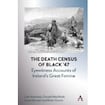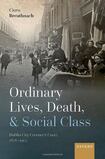

“The poor leave a faint impression on the Irish historical record,” Ciara Breathnach observes in Ordinary Lives, Death, and Social Class. Having left few written records, they tend to be represented “from above”, and the demographic is seldom disaggregated into individuals with their own names and stories.
To gain insight into the ordinary lives of the Irish poor in the 19th and early 20th century, we have to rely on other sources that mediate their stories and voices, such as official records or the writings of clergy and philanthropists. Breathnach’s monograph and The Death Census of Black ‘47 by Liam Kennedy, Donald MacRaild, Lewis Darwen and Brian Gurrin use such resources to chart the lives and deaths of Ireland’s least fortunate.
In 1847, during the Famine, the Repeal Association invited parish priests to submit reports on local mortality and conditions, hoping that this Death Census would prompt the government to increase relief measures. The Death Census of Black ‘47 brings together the 100 returns the association received, representing 10 per cent of Catholic parishes. Though published in the Pilot newspaper at the time, the census is almost completely unknown today, even among historians.
Following a useful general introduction about the Famine, the history of (informal) census-taking in Ireland, and the Death Census, the book reproduces the full text of each published return. These reports are moreover helpfully contextualised with demographic information and biographical details of the parish priest or curate who compiled it.
‘Forget about glamour’: Jonathan Anderson offers advice to would-be fashion designers as he receives TCD honour
Death of Pope Francis: Derek Mooney leads RTÉ’s coverage to intermittently jaw-dropping effect
Chob Thai restaurant, Clontarf: The most memorable thing here is the bill
Careless People: The controversial book is shocking and reveals Facebook is far worse than we could have suspected
As the authors state, there is significant variation in the statistical accuracy of reports, and the quantitative data is not the key reason why the Death Census demands attention. The priests’ qualitative reports are more significant, as many priests were “more participant observers than commentators” and “intimately engaged with the lives of their parishioners”.
The returns are replete with harrowing tales of suffering and many discuss specific cases, converting data points back into individuals. One of the bleakest submissions is that of Revd John Halanan of Ballinhassig, Co Cork who supplies a list of all 62 people who died in his parish.
Particularly noteworthy is that so many respondents draw attention to the breakdown of funerary customs as a sign of societal collapse. Multiple priests lament that parishioners are buried coffinless, and there are numerous stories of corpses that remain unburied or are interred in makeshift graves. In Bohola parish, “a poor girl of the name of O’Neill” lay unburied for nine days, so finally her “aged mother was compelled to dig a pit in the cabin floor”.
While the census had no discernible influence on government policy, it is nevertheless significant as an historical record. The authors and publishers of this collection are to be commended for opening up this valuable record to a wider audience.
The inevitable takeaway from this barrage of fatalities is that life in Dublin’s tenements was harsh and perilous
Using the records of Dublin City coronial court, particularly those kept during the long tenure of coroner Dr Louis Aloysius Byrne, Ciara Breathnach’s Ordinary Lives, Death, and Social Class draws a detailed picture of urban life as experienced by the poorest citizens of inner-city Dublin at the beginning of the 20th century. The coronial court held inquests to establish the facts surrounding sudden, violent, unnatural, and unexplained deaths. Breathnach argues that the court’s records “offer unprecedented access to ordinary lives” – not just because they examine the lives of victims, but also because they frequently quote verbatim the words of witnesses.
Across three chapters, Breathnach surveys deaths in the domestic sphere, public and workplace deaths, and violent and suspicious deaths, focusing on 611 consecutive cases between 1900 and 1902. These are cross-referenced with other sources, such as newspaper reports and insurance maps, as well as census records, particularly those of 1901.
The inevitable takeaway from this barrage of fatalities is that life in Dublin’s tenements was harsh and perilous, frequently marked by alcohol abuse, domestic violence, and the exploitation of labourers – but also typified by a strong sense of community. Many cases are truly tragic, such as the 39 preventable deaths of children caused by burns or scalds resulting from the fact that cooking facilities in the tenements were often singularly unfit for purpose.
An indispensable resource for this study are the jury riders attached to verdicts, which had no legal status yet made publicly available jurors’ opinions and prejudices beyond the bare statement of facts. Such riders show how gender and class in particular influenced public perception of individual cases, and how blame was socially constructed and attributed, disadvantaging women above all. Using such materials innovatively, Breathnach delivers a fine grained and illuminating social history of poverty in Dublin.
While focusing on familiar contexts – the dire effects of the Famine and the horrors of urban destitution – these original and valuable studies offer significant new insights about destitution in Ireland and the social and legal position of the poor. Documenting the often wretched experiences of the Irish poor through underutilised sources, they make for sobering reading.













